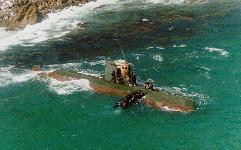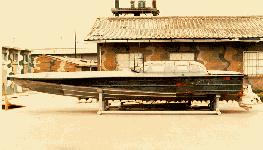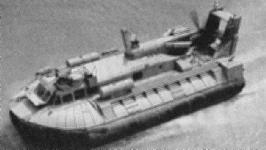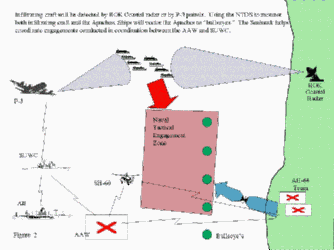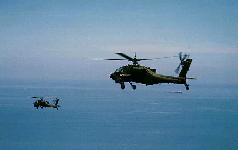ANTI-MARITIME SOF
USING INNOVATION AND SYNERGY TO
SOLVE A VERY REAL AND SUBSTANTIAL THREAT
SOF Challenge
Over the last two years, Combined Forces Command (CFC) developed and implemented a unique concept for defeating threat maritime Special Operations Forces (SOF) likely to infiltrate the shores of the Republic of Korea (ROK) from the sea. The CFC designed the concept to defeat a SOF threat specific to the Korean Theater, but other commands can apply the concept wherever U. S. forces are deployed.
After a brief description of the North Korean maritime SOF threat, this article describes how CFC developed and practiced a technique whereby Army attack helicopters, under the control of CFC’s Naval Component Command (NCC), are used to destroy threat maritime SOF before they reach friendly shores.
During 1996 this North Korean submarine floundered within 50 meters of shore. North Korea will attempt to penetrate ROK rear areas in war just as certainly as they historically have done during the armistice.
OVERVIEW on CONCEPT DEVELOPMENT
CFC’s mission is to maintain the armistice, deter war, and if necessary fight and win. The Combined Defense Team has performed this vital mission every day for the past 44 years. The strength of the Combined Defense Team is the main reason that peace and stability exists on the peninsula. Yet the military threat from North Korea has not subsided. The "Cold War" is not over and the North’s military remains formidable, unpredictable and dangerous. A significant concern is the North’s SOF, designed to wage war on a "second front." The North’s SOF are well equipped to infiltrate the ROK from the sea. The sea affords the North’s SOF their best avenue of approach. It is against this backdrop that CFC developed a concept and practiced a promising technique to counter the problem posed by North Korea’s maritime SOF.
The CFC now cross attaches Army AH-64 Apache attack helicopters, from its Ground Component Command (GCC), to its Naval Component Command (NCC) on a temporary basis, depending on the situation, to attack enemy maritime-SOF assets before they reach ROK shores. CFC initially experimented with the concept in October 1996 during its annual, theater wide, Combined Field Training Exercise: FOAL EAGLE. FOAL EAGLE is an ideal setting for practicing the anti-maritime SOF concept since the focus of the exercise is on rear area operations, and security and protection from enemy SOF. Following initial success on a small scale, CFC moved to expand the concept in time for ULCHI FOCUS LENS (UFL) 97. UFL is the CFC’s theater wide, simulation driven, Combined Command Post Exercise designed to practice execution of various parts of the theater campaign plan. UFL 97 provided an opportunity to practice the anti-maritime SOF concept on a grand scale without being cost prohibitive.
Through a series of round table discussions, CFC’s Ground Component Command and Naval Component Command developed unit training programs to fine-tune the new anti-maritime SOF concept in time for UFL 97. Analysis from UFL 97 proved that the concept was very effective in defeating an enemy maritime SOF threat.
After more refinement on Army Airspace Command and Control (A2C2) and Army attack helicopter handoff procedures to Naval airspace command and control authorities, the concept was put to test again under field conditions during FOAL EAGLE 97. CFC’s overall conclusion from these training exercises is that AH-64s enhance NCC’s ability to intercept and destroy infiltrating enemy maritime SOF elements before they reach ROK shores. This unique joint and combined team is an example of the synergistic use of capabilities from more than one service and more than one nation to effectively attack and destroy an elusive enemy target. The concept itself is an example of innovative thinking to solve a complex problem.
The Korean Challenge - Forces and Geography
The North Korean maritime SOF threat is very real, substantial and dangerous. The CFC must intercept and destroy infiltrating maritime SOF elements to prevent them from reaching the ROK coastline and infiltrating into the ROK interior to disrupt CFC’s rear operations. This is a challenging task because 86% of the ROK border is coastline, inundated with thousands of rocky islets, and is conducive to maritime infiltration operations by the North. The defense of the ROK is further complicated by the relative ease of access to its coastline from the sea and by the extraordinary size of the North’s special purpose forces, the largest in the world.
North Korean naval forces have significant numbers of watercraft of various sizes and capabilities allocated exclusively to a maritime infiltration mission. These craft include a variety of submarines, coastal patrol craft, high-speed semi-submersible craft, air-cushioned amphibious craft, and rubber raiding craft.
This SILC is a high-speed semi-submersible craft that can be used to infiltrate North Korean Special Forces. North Korea has adapted technology to focus on invading the ROK; this boat is powered by three inboard-outboard engines and is capable of submerging for limited periods.
This hovercraft is an example of what North Korea could use to infiltrate forces into the ROK.
The North Koreans expect to use these craft to infiltrate large numbers of maritime SOF units into CFC rear areas just prior to hostilities, followed by a surge of other SOF and conventional maritime forces at the outset of a major offensive. These craft will transport SOF forces capable of sustained independent operations. They will gather intelligence, perform sabotage, and disrupt CFC’s critical rear area activities supporting current and future operations. The North’s SOF are capable of a wide variety of insurgent operations and terrorist activities. CFC expects them to attack utility systems, lines of communication and population centers.
The North Korean Navy itself has over 130 air-cushioned vessels. Each is capable of carrying up to fifty fully equipped personnel. These amphibious craft can reach speeds up to 50 knots per hour and are hard to detect and interdict. Within a short period of time, North Korea can move approximately 7,000 maritime SOF personnel to many disbursed debarkation points along both coastlines of the ROK. Once ashore these small teams will attempt to evade CFC forces and move into CFC’s rear areas and ROK population centers. The key to CFC’s success is to detect the North’s maritime SOF teams early, while they are still off shore, and destroy them before they land on ROK soil.
The Naval Challenge in Perspective
In organizing the defense of the ROK against North Korean aggression the CFC designated the Commander 7th Fleet (C7F): Commander, NCC and made him the supported commander for maritime interdiction operations. While NCC surface combatants are well organized to defend the blue-water areas surrounding the ROK, the littoral areas pose a different challenge. The littoral area, generally within 12 miles of the ROK shore, restricts ship movement. Also, ships that do move in the littoral area are more vulnerable to enemy land based weapon systems. It is in this littoral area that the North intends to move its tremendous numbers of maritime SOF forces to land on ROK soil.
CFC naval forces intend to detect North Korean movement in the littoral area with their own helicopters, airplanes, shore based radars and patrol craft. However, the NCC’s helicopters and airplanes are mainly for target detection and not interdiction. That role is assigned to the NCC’s fighter aircraft, surface combatant ships, and submarines. The NCC simply doesn’t have enough resources to detect, track and destroy every enemy surface vessel, submarine, and aircraft in both the "blue water" and the littoral. Yet, the NCC’s ability to detect, track, and destroy all enemy vessels operating anywhere along the ROK coast and along sea lines of communication is critical to CFC’s campaign during the early stages of hostilities.
CFC planners considered a number of options to address North Korea’s massive maritime SOF threat. Fixed wing fighter aircraft are always an option, but it is unlikely CFC will be able to employ fighters in the anti maritime SOF role since they will be busy with counter air (CA) and air interdiction (AI) missions in support of land based operations, and defense of the fleet.
Special Operations Component-Korea (SOCKOR) could provide AC-130 Spectre gunships to attack enemy maritime-SOF, but Spectre’s are a finite resource and are vulnerable to enemy air defense systems and enemy fighter aircraft. Since Spectre is a scarce and valuable resource the CINC, CFC determines the priorities for Spectre gunships while considering the risks associated with each employment decision.
In proposing the use of Army Apache attack helicopters, planners discovered a match between the best "window" of AH-64 availability and time of greatest need in an anti-maritime SOF role. During the early stages of hostilities, when the North’s anti-maritime SOF threat is expected to be the greatest, the GCC’s AH-64s are the least committed. While the Apache’s primary mission is not anti maritime SOF, it is very capable in that role. The speed, armament, navigation, and communications suite of the Apache is ideally suited for long range target detection and attack, even in the littoral areas of the ROK .
In the early stages of hostilities, Ground Component Apache helicopters await employment against critical targets. A number of them can be called upon to complete anti maritime SOF missions if the situation warrants their release to NCC control.
Planning and Execution
By using its experience from many exercises the past two years, CFC created a sequence of planning and execution for Apache anti maritime-SOF missions. The Assistant Chief of Staff, C2, monitors the North’s military activity 24 hours a day. As soon as C2 detects unusual or threatening North Korean military activity they warn CFC forces and surge collection systems on specific indicators of an impending attack. In the meantime, the CINC directs CFC forces to initiate defensive measures appropriate to the situation. Off the ROK shores, the combined coverage of ROK and U.S. P-3 aircraft, AWACS and ROK Navy coastal radars focus detection operations on the most likely littoral areas and maritime approaches.
Either AWACS or P-3 aircraft coordinate attack of detected targets until U.S. Navy combatants arrive off the coast of the ROK. The NCC then uses the Navy Tactical Data System, a digital communications system that blends U.S. and ROK sensor outputs into an integrated common operational picture, to deconflict, handoff and attack threat systems.
Once CFC recognizes the appropriate indicators, the C7F requests the CINC’s release of GCC attack helicopters to anti maritime-SOF operations. When the CINC decides to use AH-64s in that role, the Army attack aviation brigade gets the mission and begins its preparation.
The brigade itself remains under the operational control (OPCON) of the ground component commander, but two attack helicopter battalions are placed under the tactical control (TACON) of the NCC for planning and execution. CFC can release these two battalions to NCC control, for anti maritime SOF operations, when they are not involved in ongoing deep attack. Under this command and control relationship, the NCC has the authority to move and position attack battalion assets once they enter the NCC area of operations. The CFC commander can terminate the mission at any time if the battalions are needed elsewhere. By using two battalions, the brigade commander can respond quickly to missions occurring on both coasts from assembly areas that facilitate rapid interdiction well off both shores of the ROK.
Once the Brigade Commander gets his mission he establishes initial communications through the Peninsula C4I Network, using the Tri-service Tactical Communications System (TRI-TAC), in order to talk to the NCC. The commander dispatches a brigade liaison (LNO) team, including S-2 (intelligence) and S-3 (operations) representatives, to board the designated Navy command and control ship. The attack battalions move to both coastlines to establish assembly areas and to prepare for operations. The brigade headquarters coordinates land and local security requirements with the responsible ground commanders. The battalions then move to, occupy and stage from designated assembly areas to perform their missions in the Navy’s maritime area of operations.
The Navy command and control ship has control over all maritime activity in the naval operational area. The command and control ship exercises both functional and geographic control. The NCC establishes a functional Anti-Surface Warfare (ASUW) command for each coast. Each ASUW Commander (AUSWC), located aboard a cruiser or destroyer, is responsible for functional control of surface warfare within his assigned geographic area.
The NCC Waterspace Management Scheme allocates each Naval surface and subsurface combatant decentralized responsibility for portions of the NCC’s area. The NCC also establishes a separate Anti-Air Warfare (AAW) command, generally located aboard an AEGIS equipped cruiser or destroyer. The AAW Commander (AAWC) is functionally responsible for anti-air warfare in his area of operations. The AAWC coordinates engagement of hostile aircraft and protection of friendly aircraft within his respective area, similar to the ASUW function.
Each attack battalion dispatches an LNO team aboard the anti-air warfare (AAW) ship on its respective coast to ensure that attack operations are properly coordinated with the NCC and its subordinate functional and geographic commands. (Diagram 1: C4I)
Target Detection and Engagement
The aircraft or surface combatant that first detects an unknown contact is usually designated the Scene of Action Commander (SAC). The SAC determines whether the contact is friend or foe and coordinates an attack against positively identified enemy contacts unless the mission is transferred to another SAC. The responsible SAC communicates with the appropriate ASUW or AAW to obtain execution authority.
For surface targets, the ASUW designates the nearest capable surface ship to attack the target. For enemy targets in the air, the AAW ship coordinates the attack with a system best able to respond quickly. In the event the NCC command and control ship designates an aircraft to strike a surface target, the AAW coordinates the airspace and the ASUW directs its attack against the enemy vessel.
When the NCC commander decides to use attack helicopters, the command and control ship sends an execute message to the aviation brigade. Each attack helicopter battalion has two aircraft on standby, ready to respond to missions from the NCC. The message contains the necessary information to enable the crew of the AH-64s to communicate with the AAW ship.
The attack battalion coordinates movement to and from the coast through Army airspace command and control (A2C2) channels. Army A2C2 provides a transponder identification friend or foe (IFF) squawk for flight-following. An IFF code prevents fratricide of the Apaches since it gives the A2C2, air defense and Air Component Command (ACC) elements the ability to track the attack helicopters throughout the GCC area of operations. This minimizes the risk to the Apache crews while they transit CFC rear areas. Once the aircraft reach the coast, they cross into the NCC Commander’s area and must comply with naval airspace coordination measures. The aviation brigade and attack battalions determine any change to the NCC’s procedures during planning and coordination for each mission.
An AH-64 Team flies off the coast enroute to a bullseye. Typically this mission would be conducted at night. Close crew coordination becomes more important due to the low contrast conditions over water.
The AAW ship also uses an IFF code to track the movement of the Apaches. As an added measure of fratricide prevention, the NCC’s airspace is procedurally de-conflicted by altitude as well. The Apaches remain at or below 200 feet above sea level (ASL) while naval fixed wing aircraft stay at 600 feet or higher ASL.
The Apaches then contact the SAC that is tracking the inbound enemy target or targets to arrange for battle hand over. The Apache crews use the aircraft’s speed and in-flight navigation systems to quickly arrive at the target area. Once on the scene they acquire the target using their onboard day-TV or forward looking infrared radar (FLIR) systems.
The Apaches must positively identify a target as enemy before they get authorization to attack. The ASUWC authorizes an attack when enemy contact is confirmed by the Apache crews. Upon authorization from the ASUWC, the Apaches use running fire from a standoff position as many times as necessary to destroy the enemy force. The crew’s principle weapon for the mission is Hellfire but they carry an appropriate supply of 30MM cannon ammunition on board too.
Since the enemy’s maritime SOF teams are small and the vessels they ride in are point targets, the Apache crews are able to coordinate their fires with each other to prevent waste of ammunition and target overkill. If during an engagement the ASUWC designates additional targets, the AAWC can send the same aircraft to the new contact or arrange the launch of the next Apache team waiting back in the holding area.
The Apache crews perform their own battle damage assessment (BDA) and send their assessment through the SAC to the ASUW. At the end of the mission the NCC may direct other assets to perform a more detailed BDA. The Navy could direct SEALs to perform boarding, rescue and scuttle missions.
In the event an Apache is shot down, the NCC immediately performs search and rescue operations.
Issues Resolved
CFC Component Commanders raised several issues during the development of the theater anti maritime SOF concept. CFC felt the vulnerability of two widely separated ROK coastlines necessitated the allocation of two GCC attack helicopter battalions TACON to the NCC to cover both coasts simultaneously.
Two battalions can position forward arming and refueling points near each coast to maximize response time, aircraft availability and station time. Also, by using external fuel tanks the battalions can extend their range of operations and loiter time.
Over several exercises, the attack battalion’s learned that it was easier to operate from land rather than sea, even though they are trained to operate from NCC ships. The NCC concurred because this facilitates a ship’s freedom of movement, reduces its vulnerability to shore-based weapons, prevents disruption of concurrent deck functions, and eliminates cross-service logistical requirements.
Clearly stated command and control relationships enable the battalions to remain responsive to the CINC’s priorities for contingencies ashore and facilitate rapid turn around from the anti maritime SOF role to more traditional missions.
The aviation brigade can sustain crew anti maritime SOF training with as little as 6 flying hours per month. The NCC can easily support joint training with Army aviation with minimal impact.
Should weather turn unfavorable, the Apaches land on a helicopter capable ship or return to shore whichever is closer and safer. During one training exercise on the ROK west coast, heavy fog did not affect the ability of an Apache to either acquire or attack simulated enemy targets.
Conclusion
A hovercraft can easily approach the many islands or extended coastline on the ROK peninsula. Key to defense, the AH-64 can prevent assaulting forces from ever reaching ROK coastal areas
Three times during the past year, CFC’s Army attack helicopter units practiced the anti-maritime SOF concept with the Navy. Aviation commanders believe this is an important mission for which the Apache is well suited. While the Apache’s primary role continues to be anti-tank in the land battle, it is a system just as formidable in an anti maritime-SOF role.
A little over two years ago, what began as an idea evolved into a viable concept. The CFC carefully planned, trained, and tested its AH-64 anti maritime SOF concept before accepting the technique as a viable alternative. As a result of some innovative thinking and the synergistic effects of the GCC and NCC, the CFC is stronger and better prepared to protect the ROK in the event of renewed hostilities.
The CFC also accumulated other intangible benefits associated with the concept development process. Working on a solution to a very real and substantial North Korean threat brought the Joint and Combined Team closer together. Each component’s understanding of each other’s abilities and capabilities grew while working together to solve a common problem. Joint and Combined team work is essential for unity of effort in time of peace or conflict.
The CFC developed a concept with a specific North Korean threat in mind. The CFC anti maritime SOF concept enables joint force planners to maximize a finite number of resources to achieve the best possible effect against an illusive enemy. The result in the Korean Theater is a Joint and Combined Defense Team better able to deter aggression and if necessary to fight and win.
SOURCE: U.S. Forces Korea CINC's READING PROGRAM

